“Why do you go away? So that you can come back. So that you can see the place you came from with new eyes and extra colors. And the people there see you differently, too. Coming back to where you started is not the same as never leaving” – Terry Pratchett
I have been in China for a while now. I had yet to take the time to form a real catalogue of my journeys, while I am overseas. I decided that I should first tell of my love for traveling and where it all began.
When I was young, my father was in the Marines. That meant that mom and I traveled a great deal between where we lived near the military base and our hometown. We made that trip several times before I was 4 years old. As a result, I was open to travel from a very young age. When my sister was born, my family settled down in my home town. This, however, did not thwart my wanderlust, nor slow our exploration.
My childhood was filled with trips, vacations, family reunions, and travels. I began to explore new regions of the world. My most memorable earlier journeys were into the mountains of West Virginia. My parents and grandparents took my sister and I to camp with a group that was partly family and partly friends that worked with my grandparents. We often played in the clearings and the streams. We hiked long trails over the moutains and looked out over the cliffs, exploring the woods. I visited Seneca Rocks, Dolly Sods, Blackwater Falls, and so many more scenic locations in West Virginia.
I loved the mountains. We went sometimes twice a year. I always looked forward to our trips into the wilderness. The dew in the grass, the wind in the trees, the smell of burning wood, the sound of flowing water. These things are magical – they hold the beginnings of my exploration as a child. I remember wandering off alone or in a group of children to explore the hills and forests. There was always good food, and the fire would almost always smell of firewood and something tasty.
Another fond set of vacations was my family’s yearly camping trips to the lakes in West Virginia. We alternated between Burnsville Lake and Summersville Lake. These trips always included boat rides, swimming, hiking, visiting the historical areas of the towns nearby, and good food. My grandfather would drive his boat and pull the kids (and the braver adults) behind the boat in innertubes. We would stay for a week at a time. It was usually the longest regular vacations we had.
We did not travel to West Virginia alone. We also took trips to other parts of the country. My great grandfather, Papooh, often took us kids to Forked Run Park in Ohio. There was a lake and waterfall, campground and beach area. It was always a fun place to visit. We usually only went for a day, returning in the evening, but it was something I remember looking forward to all the same. We would drive in the old station wagon, fighting over who would sit in the dummy seats in the rear of the car. It was also where I learned to swim. Despite my family taking my to the local YMCA to learn when I was young, I had not truly learned to swim until one of our trips to forked run, when Papooh taught me.
My family also took vacations to Tennessee, visiting the Great Smoky Mountains – Gatlinburg and Pigeon Forge. We also stayed with my Aunt Mysty, Zippy, who lived in Nashville. My grandparents also took us to visit Dollywood – the mountain area theme park, based loosely on the WV, KY, TN area and Dolly Parton’s life. We would go to North Carolina and visit my grandparents’ friends in the Outerbanks. Also, once a year, we had a “Pig Pickin'”, which was a friend and family weekend barbecue event with music and food. We would go to Myrtle Beach in South Carolina. I even remember visiting family in Missouri and Arizona.
All of the places, all of the sights, smells, sounds, all of this was before I was even 13.
When I became a teenager, things changed. My sister, cousins, and I became more and more busy with school and other activities to do as much traveling. We still went to the mountains and the lakes each year, but our extra trips became far fewer. I had already been to many of the states around the country, almost all – except the farthest ones. I had seen so many things. During my teenage years, there were two bigger trips. This first was when a large part of my family went to Walt Disney World in Orlando. We drove, which allowed me to see a majority of the South that I had not already seen. It was a fun time together. The second was a trip with my church to the northern reaches of Canada for ministry and outreach work. We went into the Algonquin National Park in Northern Ontario, helping the villagers and preaching to them. It was a wonderful experience and my first trip out of the country.
Throughout the rest of my teenage years, I continued to travel when I could, with my family and friends. Before going to college, I managed to visit all of the states of the continental United States. I had been to one country outside of my own. I had traveled so much, I had seen and experienced so much, and yet I was so young.
My first year in college changed my traveling yet again. I got to spend time in Europe. I stayed in Belgium, while visiting Netherlands, Germany, France, Luxembourg, and Switzerland. It was another wonderful opportunity in my life. I got to explore a whole new continent, seeing the ancient beauty of Western Europe. I stayed in a small village outside Brugge, Belgium. I took trips with my classmates to Amsterdam, Koln, Berlin, Paris, Luvern, and many other wonderful places.
I loved the culture and atmosphere in Europe. It was where most of the American culture originated, yet it felt so foreign, so old. I did not try to stay in heavy tourist areas, eating only familiar foods. I became a local – going places locals went, eating local foods. I grew as a human. I saw the world completely different from how I had as a child. I saw more people and more culture, and I began to understand people who were nothing like me.
I have traveled many places. I have seen many things. Throughout my journeys, my mountains call to me. No matter how far I go, West Virginia is still my home.




























































































































































